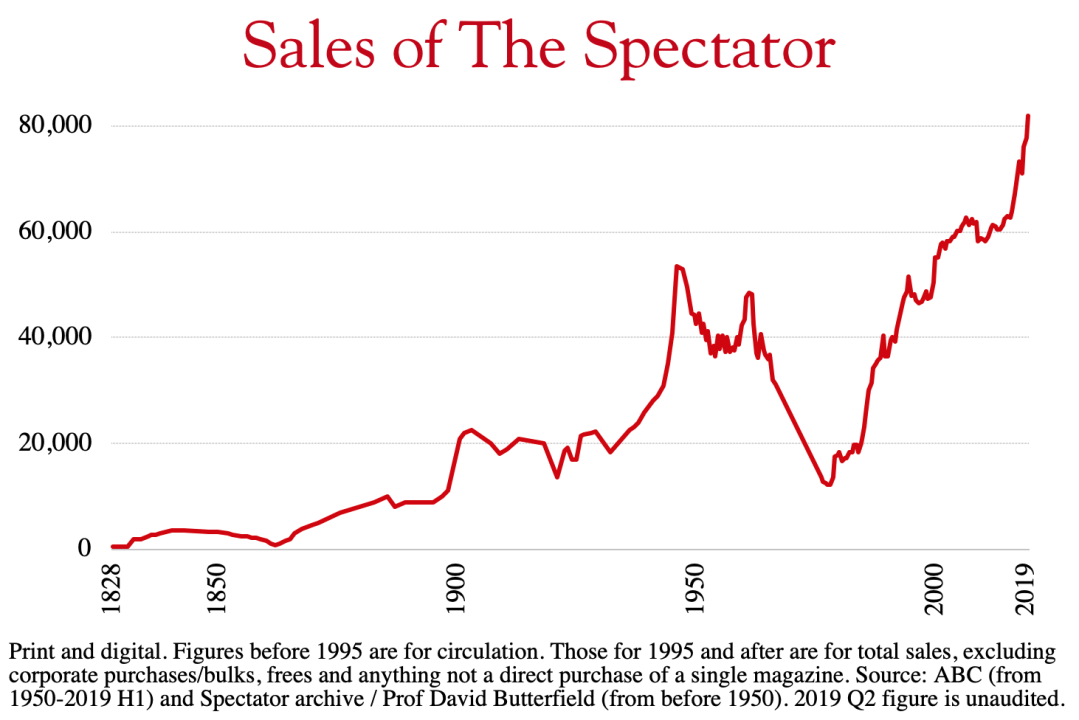As we reach the end of an incredible year, we at The Spectator are delighted to announce our latest sales figures: 81,900 for the third quarter of this year. That means we close this decade with sales up 43 per cent, in a magazine market that has declined by 63 per cent. Not bad for the world’s oldest weekly. And while we have a lot of digital-only sales, our print sales are also at all-time high: so digital is driving the success of print.
There has been an avalanche of political news in Britain, but the same is true all over Europe. So we looked at 36 European current affairs magazines over the last five full years (2013-18) using the standard industry figures. Of those 36, only eight are selling more than they were four years ago; six of them British: the Economist, Prospect, Private Eye, the Oldie and the New Statesman (going through a renaissance under Jason Cowley). At a time when publishing is supposed to be in chaos, British current affairs magazines are defying the trend. And we’re delighted to say, of all the current affairs titles in the continent, that The Spectator has been the fastest riser, with sales up 26 per cent.
This has allowed us to invest more in journalism and in developing a comprehensive package for our subscribers. Over the years, we have redefined the notion of subscription. Sign up and, yes, you get the world’s best print magazine. But you also get much more, cut from the same cloth. Including:-
- Coffee House, our blog, which offers live comment on the day’s events long before the newspapers are ready. So far this year, 28 million people visited to our website, reading 68 million pages. Another record high.
- Podcasts, including The Edition (a discussion of the week’s events) and Coffee House Shots. In the summer, we announced that our podcasts had broken through a million monthly listens. That’s now 1.5 million.
- Our daily emails including Isabel Hardman’s Evening Blend, now the UK’s most-read political email.
- Apps for iPhone, iPad and Android, so you can download the edition at 4 a.m. on Thursday, wherever you are in the world.
- Invitation to our events, which welcomed 14,400 people this year. We sold all 1,000 tickets to our review of the year last week and next up is a debate about offering asylum to illegal immigrants.
- And our online archive, the oldest of any weekly, dating back to 1828.
The Spectator’s formula is pretty much unchanged since the first issue of the first Spectator was published in 1711 (here’s my telling of that story): humour, variety of opinion, a rejection of partisanship. The most-read articles are a rich mix from those against Brexit (Matthew Parris, Nick Cohen, Alex Massie) and those in favour (Charles Moore, Rod Liddle, Lionel Shriver). The whole point of The Spectator is that we can agree to disagree, and enjoy the process. It’s a refuge from the shrillness of social media debate.
Another milestone lies around the corner. In April next year, The Spectator will become the first magazine in history to publish a 10,000th edition. To do this with sales at a record high is achievement made possible for you, our readers. So: thank you. And stay with us: we’re just getting started. And to those who’d like to know what the fuss is about, try us for free for a month here.
PS: For those interested, here’s our zoomed-in sales graph for the last two decades showing a print and digital split. And no, these figures don’t contain bulks, giveaway issues, smoke, mirrors or any other nasties: it’s the figure for clean sales. The Spectator is the only UK publication to offer full 20-year transparency over sales figures: they can be found here.








Comments